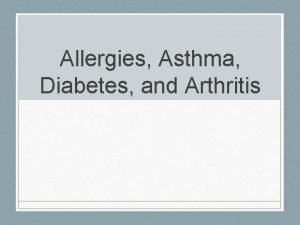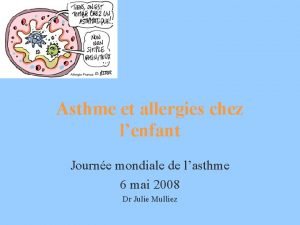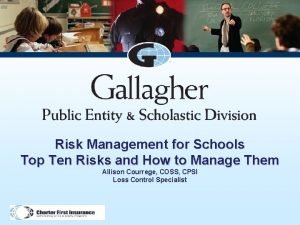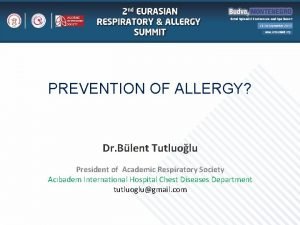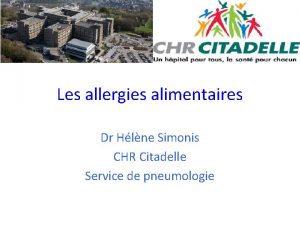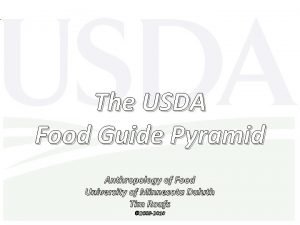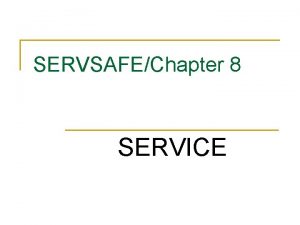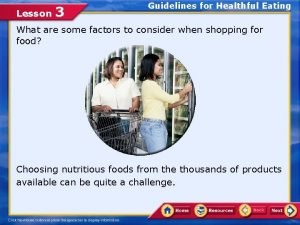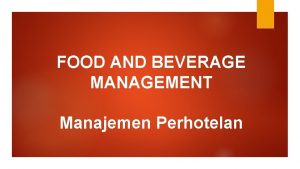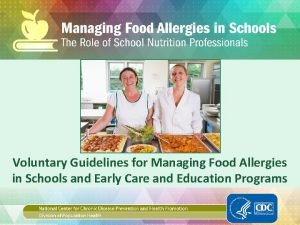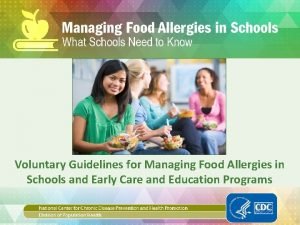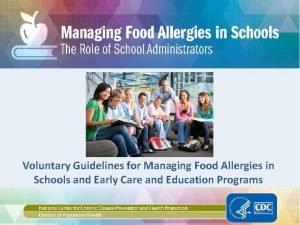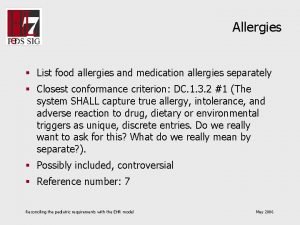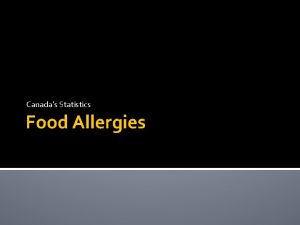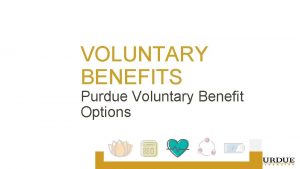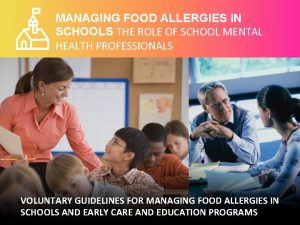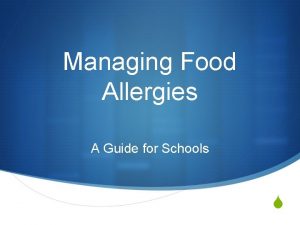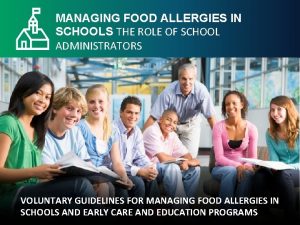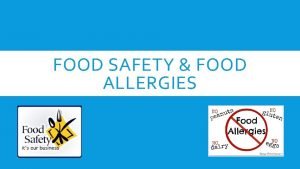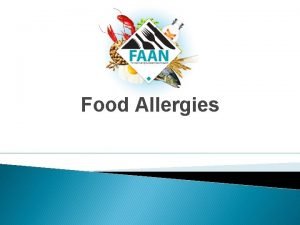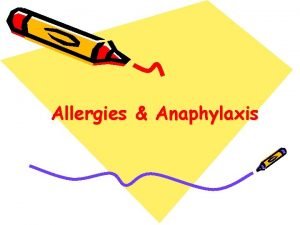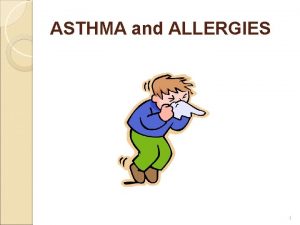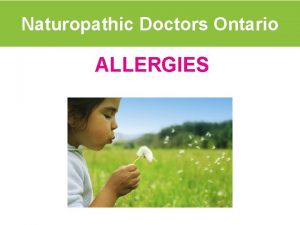Voluntary Guidelines for Managing Food Allergies in Schools



















- Slides: 19

Voluntary Guidelines for Managing Food Allergies in Schools and Early Care and Education Programs

Objectives Describe the symptoms of food allergies and life-threatening reactions. Identify three actions to prepare for and respond to food allergy emergencies. Identify three ways to create and maintain healthy and safe classrooms and schools for students with food allergies. 2

Overview The guidelines can help schools manage the risk of food allergies and severe allergic reactions in students. Managing food allergies requires a partnership between families, health care providers, and schools. 3

Did you know? In a classroom of 25 students, at least 1 student is likely to be affected by food allergies. About 20% of students with food allergies (1 of 5) will have a reaction while at school. 25% of severe food allergy reactions (1 of 4) at school happen to students with no previous known food allergy. 4

What can you do? Plan! n Know your school district’s food allergy policies and rules. n Know your school’s Food Allergy Management and Prevention Plan. n Help develop and carry out Section 504 and IEP plans for students with food allergies, as appropriate. n Become familiar with student food allergy emergency plans. 5

What can you do? Get trained! n Participate in training and review resources. n Know the signs and symptoms of food allergies and how to respond in an emergency. 6

What can you do? Learn about food allergies! n A food allergy is an adverse immune system reaction that occurs soon after exposure to a certain food. n Any food can cause a food allergy, but most are caused by milk, eggs, fish, shellfish, wheat, soy, peanuts, and tree nuts. n A severe life-threatening allergic reaction is called anaphylaxis. 7

What can you do? Recognize food allergy symptoms! n Food allergy symptoms can include: t Swollen lips, tongue or eyes t Itchiness, rash or hives t Nausea, vomiting, or diarrhea t Congestion, hoarse voice, or trouble swallowing t Wheezing or difficulty breathing t Dizziness, fainting or loss of consciousness t Mood change or confusion 8

What can you do? Know how to respond to food allergy emergencies! n If you suspect an allergic reaction or anaphylaxis, call the school nurse or administrator immediately. n Never send a student with a suspected allergic reaction to the school nurse alone. n The recommended first-line treatment for anaphylaxis is the prompt use of an injectable medication called epinephrine. 9

What can you do? If you suspect an allergic reaction or anaphylaxis n Activate the student’s food allergy emergency plan. n Be ready to administer an epinephrine auto- injector if you are delegated and trained to do so. n Call 911 or the emergency medical system immediately. All students with anaphylaxis must be monitored closely and evaluated as soon as possible in an emergency care setting. 10

What can you do? Help manage food allergies at your school. n Know which students in your classes have food allergies. n Keep student emergency care plans in an easy to reach, secure location. n Share information with other school staff who need to know. 11

What can you do? Help prevent food allergy emergencies! n Make classroom modifications to make sure all students can participate fully in class. n Avoid using allergens in classroom activities, including arts and crafts, counting, science projects, parties, holidays and celebrations, or cooking. n Inform parents and school nurse or administrator prior to any activities that may include food or known allergens. 12

What can you do? Create and maintain a healthy and safe classroom! n Follow school district rules and practices for dealing with food allergies. n Review rules with students and parents. n Ensure that each student with a food allergy is aware of their allergy and how to avoid the allergen. n Help prevent bullying and report all incidents to administrator. 13

What can you do? Create and maintain a healthy and safe classroom and school! n Provide supervision in the cafeteria, when meals or snacks are served in the classroom, on field trips, and during extracurricular activities. t Enforce hand washing before and after eating. t Clean surfaces to prevent cross-contact of allergens when meals or snacks are served in the classroom. t Do not allow students to trade or share food. 14

What can you do? Prepare for field trips! n n Determine if location is safe. Plan ahead of time with food services and school nurse for food and medication needs. Ensure a trained staff member attends. Be prepared for a food allergy emergency. t t Have emergency plans and medications with you. Charge your phone and know where nearest emergency services are located. 15

Where can you find more information? 1. CDC’s Voluntary Guidelines for Managing Food Allergies in Schools and Early Care and Education Programs. Available at www. cdc. gov/healthyyouth/foodallergies/. 2. Allergyhome. org resources for schools. Available at http: //www. allergyhome. org/schools/. 3. 4. Food Allergy Resource and Education (FARE). Available at http: //www. foodallergy. org/resources/schools. 5. Michigan State University Extension, Alternatives to Using Food as a Reward. Available at http: //www. michigan. gov/documents/mde/foodrewards_290201_7. pdf. 6. National Association of School Nurse (NASN), Food Allergy and Anaphylaxis Tool Kit. Available at http: //www. nasn. org/Tools. Resources/Food. Allergyand. Anaphylaxis. 7. NEA Health Information Network. Food Allergy Book: What School Employees Need to Know. Available at http: //www. neahin. org/educator-resources/foodallergybook. html. 16

Questions ? 17

References 1. Branum AM, Lukacs SL. Food allergy among U. S. children: trends in prevalence and hospitalizations. NCHS Data Brief. 2008; 10: 1 -8. 2. Liu AH, Jaramillo R, Sicherer SH, et al. National prevalence and risk factors for food allergy and relationship to asthma: results from the National Health and Nutrition Examination Survey 2005 -2006. J Allergy Clin Immunol. 2010; 126(4): 798806. e 13. Nowak-Wegrzyn A, Conover-Walker MK, Wood RA. Food-allergic reactions in schools and preschools. Arch Pediatr Adolesc Med. 2001; 155(7): 790 -795. 4. Mc. Intyre CL, Sheetz AH, Carroll CR, Young MC. Administration of epinephrine for life-threatening allergic reactions in school settings. Pediatrics. 2005; 116(5): 1134 -1140. 5. Sicherer SH, Furlong TJ, De. Simone J, Sampson HA. The US Peanut and Tree Nut Allergy Registry: characteristics of reactions in schools and day care. J Pediatr. 2001; 138(4): 560 -565. 6. The Food Allergy & Anaphylaxis Network. Food Allergy News. 2003; 13(2). 7. Boyce JA, Assa’ad A, Burks AW, et al; NIAID-Sponsored Expert Panel. Guidelines for the diagnosis and management of food allergy in the United States: report of the NIAID-sponsored expert panel. J Allergy Clin Immunol. 2010; 126(suppl 6): S 1 -S 58. Lieberman J, Weiss C, Furlong TJ, Sicherer SH. Bullying among pediatric patients with food allergy. J Allergy Clinical Immunol. 2010; 105: 267 -271. 9. Cummings AJ, Knibb RC, King RM, Lucas JS: The psychosocial impact of food allergy and food hypersensitivity in children, adolescents and their families: a review. Allergy. 2010; 65: 933 -945. 18

Thank You 19
 Indirect voluntariness examples
Indirect voluntariness examples Allergies and arthritis
Allergies and arthritis Arthritis and food allergies
Arthritis and food allergies Risk management for schools
Risk management for schools Powerschool login huntsville city schools
Powerschool login huntsville city schools Reach schools safety schools and
Reach schools safety schools and Allergic conjunctivitis icd 9
Allergic conjunctivitis icd 9 Beta glucan allergies
Beta glucan allergies Allergies croisées tableau
Allergies croisées tableau Unit 2 food food food
Unit 2 food food food Food chain sequence
Food chain sequence Diet pyramid
Diet pyramid Guidelines for holding food
Guidelines for holding food Moderation in a healthful eating plan involves
Moderation in a healthful eating plan involves Food and beverage preparation service management
Food and beverage preparation service management Fspos vägledning för kontinuitetshantering
Fspos vägledning för kontinuitetshantering Novell typiska drag
Novell typiska drag Nationell inriktning för artificiell intelligens
Nationell inriktning för artificiell intelligens Returpilarna
Returpilarna Varför kallas perioden 1918-1939 för mellankrigstiden
Varför kallas perioden 1918-1939 för mellankrigstiden

